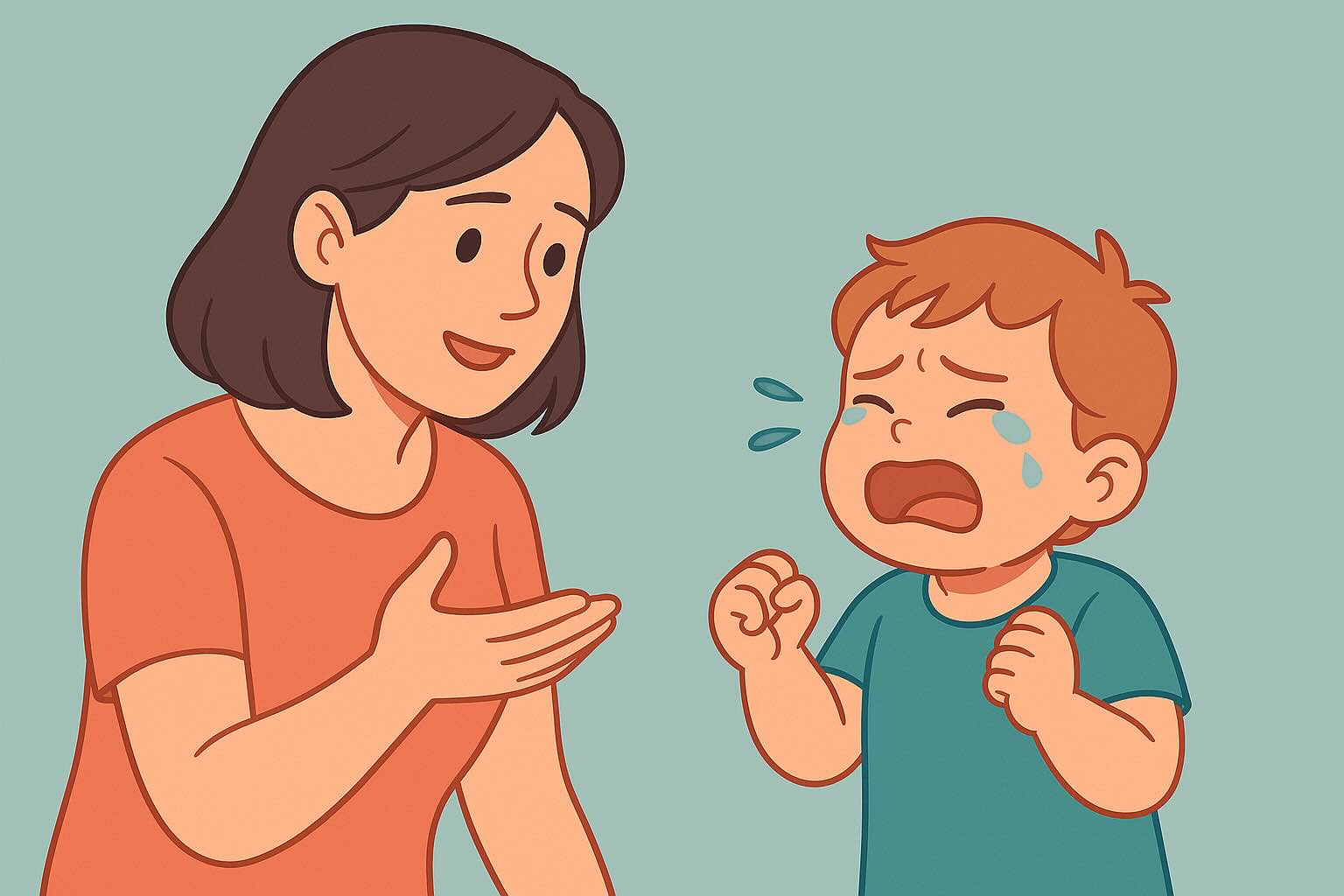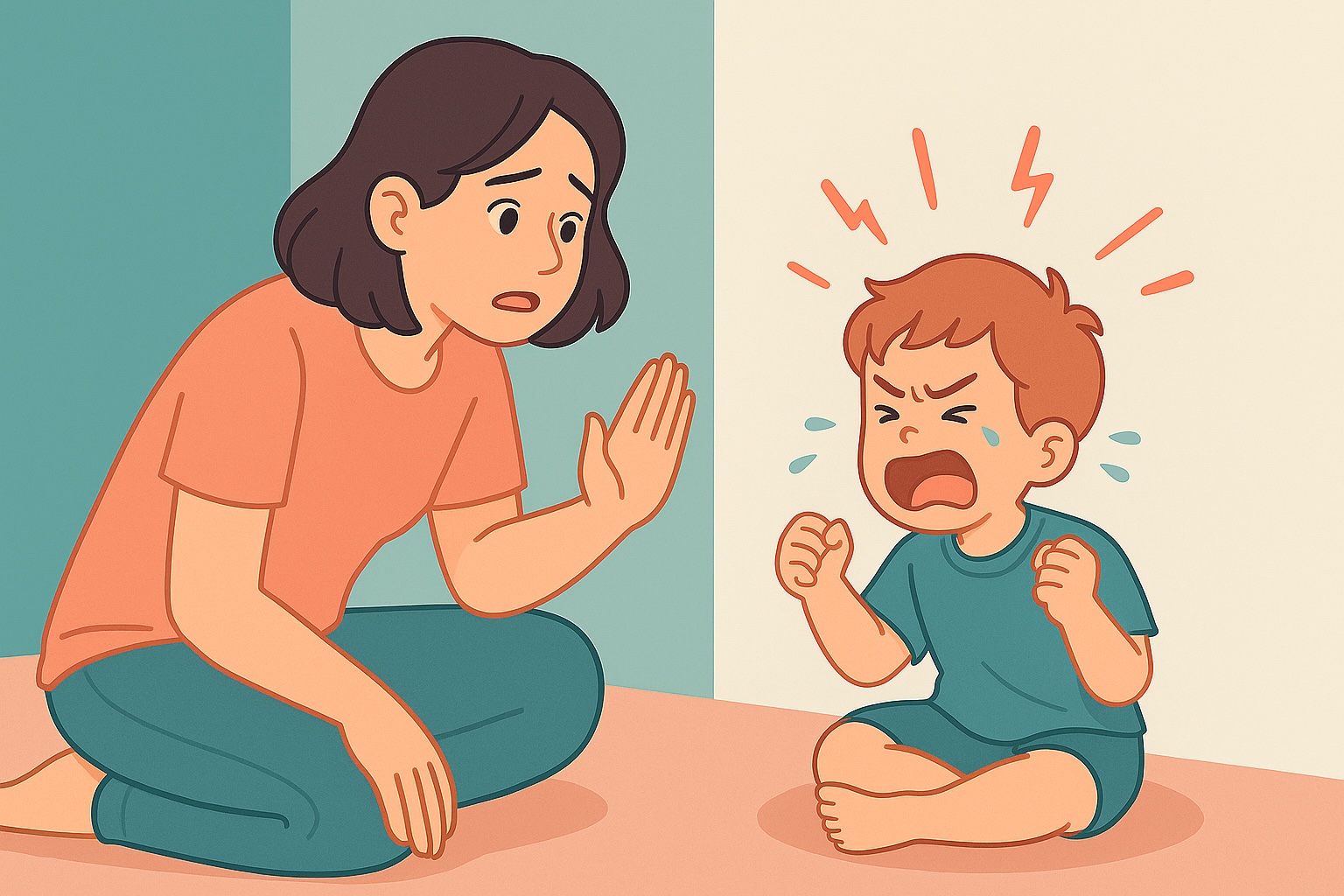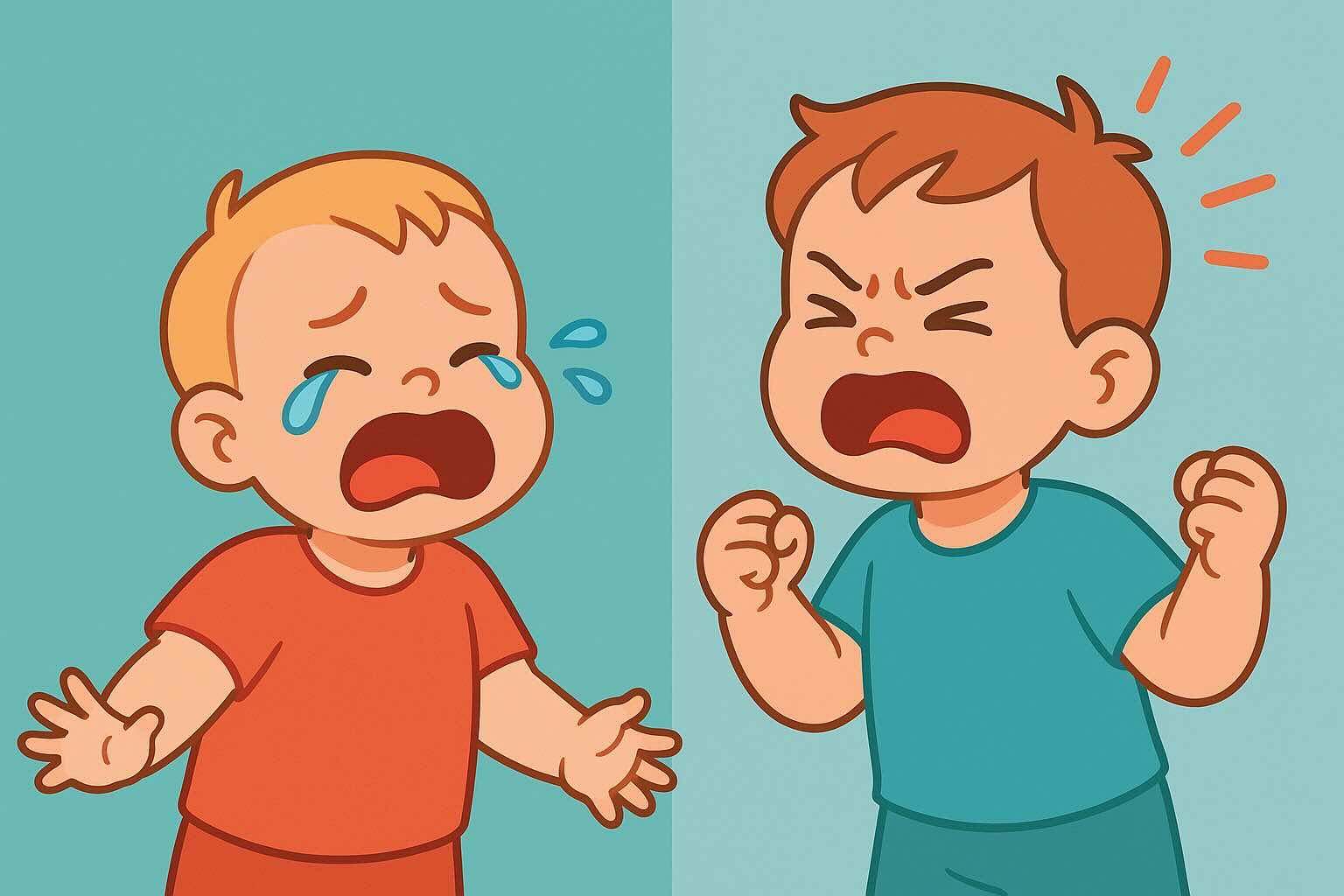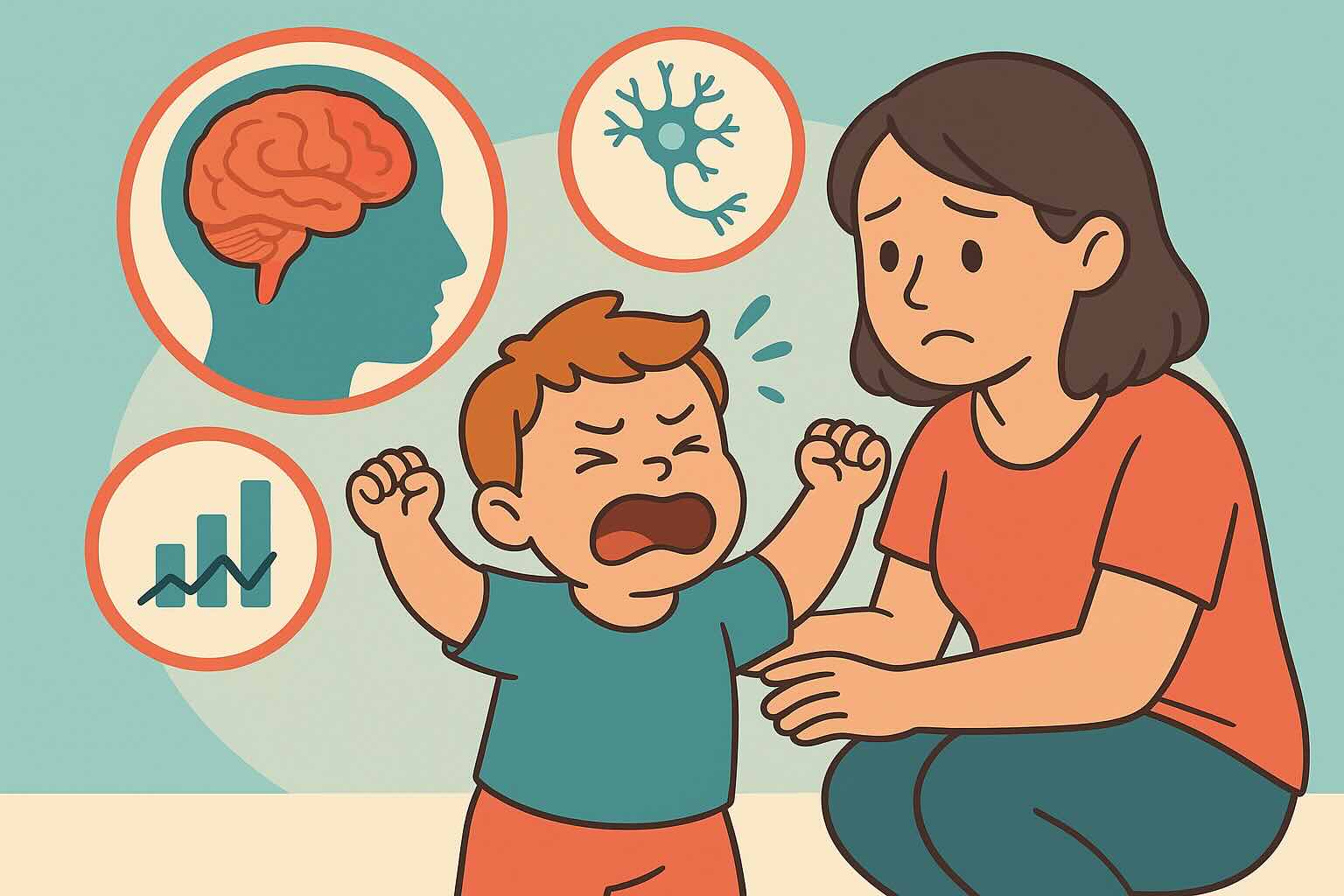What to Say During Toddler Tantrums: Scripts That Actually Work


In the heat of a toddler meltdown, finding the right words feels impossible. You want to help, but everything you say seems to make it worse. Research shows that specific phrases can reduce tantrum intensity by 60% and duration by 40% when used consistently, while the wrong words can escalate emotions and prolong meltdowns.
This comprehensive guide provides evidence-based scripts tested by child development researchers and refined by thousands of parents. You'll learn exactly what to say—and what never to say—during different types of tantrums, with age-appropriate language that supports your child's developing emotional regulation skills.
For comprehensive tantrum management, also check our complete tantrum guide and trigger prevention strategies. To understand the developmental science behind tantrums, our tantrum science guide explains why toddler brains respond to these communication techniques.
What You'll Learn About Tantrum Communication
- The Science of Validation - Why certain words calm the nervous system
- Age-Specific Language Development - Matching scripts to your child's comprehension level
- The BREATHE Method - A research-backed communication framework
- Scripts for Every Situation - Pre-tantrum, during meltdown, and post-tantrum phrases
- Boundary-Setting Language - How to validate feelings while maintaining limits
- Mirror Neurons and Co-Regulation - Using your calm to create their calm
- Common Mistakes to Avoid - Phrases that accidentally escalate tantrums
- Building Long-Term Emotional Intelligence - Teaching regulation through communication
Estimated reading time: 9 minutes
The Science Behind Words That Calm
How Language Affects the Developing Brain
During a tantrum, your toddler's amygdala (emotional center) is in overdrive while their prefrontal cortex (rational thinking) goes offline. The right words can literally change their brain state by activating the parasympathetic nervous system and beginning the process of emotional regulation.
Key research findings:
- Validation reduces cortisol (stress hormone) levels by 23% within 3 minutes
- Naming emotions activates prefrontal cortex regions while calming the amygdala
- Mirror neurons allow children to "feel" your emotional state through your voice tone
- Repeated validation experiences strengthen neural pathways for self-regulation
The Power of Co-Regulation
Co-regulation is the process where your calm nervous system helps regulate your child's overwhelmed nervous system. Research shows that 55% of communication impact comes from body language, 38% from tone of voice, and only 7% from actual words—but the right words amplify the calming effect significantly.
How co-regulation works:
- Your calm presence signals safety to their nervous system
- Consistent, soothing voice tone activates their vagus nerve
- Predictable responses help them learn what to expect during emotional storms
- Over time, they internalize your external regulation as their own self-regulation skills
Age-Specific Language Development for Tantrum Scripts
18-24 Months: The Foundation Phase
Language comprehension: Understands 5x more than they can express, typically 50-200 words receptively
Optimal script characteristics:
- 1-3 words per concept
- Simple emotion words: mad, sad, hurt, scared
- Lots of repetition and consistency
- Physical comfort combined with words
Example scripts:
- "You're mad. Mad is hard."
- "Big feelings. I'm here."
- "Sad. Mama understands sad."
- "Safe. You're safe with me."
2-3 Years: The Expansion Phase
Language comprehension: 1,500-2,000 words, beginning to understand complex sentences
Optimal script characteristics:
- 3-5 words per sentence
- More specific emotion vocabulary
- Simple cause-and-effect language
- Beginning boundary explanations
Example scripts:
- "You feel really frustrated right now."
- "It's hard when we can't have what we want."
- "Your body is showing me you're upset."
- "Mad feelings are okay. Hitting is not okay."
3-4 Years: The Integration Phase
Language comprehension: 3,000-5,000 words, can follow multi-step instructions
Optimal script characteristics:
- Full sentences with emotional nuance
- Problem-solving language
- Future-focused thinking
- Complex validation with boundaries
Example scripts:
- "I can see this is really disappointing and frustrating for you."
- "Sometimes we have big feelings about things that are important to us."
- "Your feelings make sense, and we still need to follow our family rules."
- "When you're ready, we can think about what to do next."
The BREATHE Method: Your Evidence-Based Communication Framework
Research from developmental psychology shows this six-step approach reduces tantrum intensity and teaches emotional regulation:
B - Breathe and Stay Calm (Your Foundation)
Your first job is regulating your own nervous system. Take a deep breath, lower your shoulders, and soften your voice. Your child's mirror neurons will pick up your emotional state within seconds.
Self-regulation scripts (think or whisper to yourself):
- "This is hard for both of us, and we'll get through it."
- "Their big feelings are information, not a personal attack."
- "I can stay calm while they learn to handle emotions."
Visible calm behaviors:
- Slow, deep breathing
- Relaxed body posture
- Soft facial expression
- Getting down to their eye level
R - Recognize the Emotion (Name It to Tame It)
Dr. Dan Siegel's research shows that labeling emotions activates the prefrontal cortex while reducing amygdala reactivity. This neurobiological process literally helps calm the nervous system.
Recognition scripts by age:
18-24 months:
- "Mad!"
- "Sad face"
- "Big feelings"
- "Upset"
2-3 years:
- "You look angry"
- "I see frustration"
- "That made you sad"
- "You're disappointed"
3-4 years:
- "You seem really frustrated that the tower fell down"
- "I can see how disappointed you are about leaving the park"
- "Your body is telling me you feel overwhelmed right now"
- "You're showing me that you're angry and maybe a little scared"
E - Empathize and Validate (Connect Before You Correct)
Validation is NOT agreement—it's acknowledging that their feelings make sense from their perspective. This step is crucial for building emotional safety and trust.
Validation scripts that work:
Universal validation:
- "That's really hard"
- "I understand why you're upset"
- "That makes sense"
- "Anyone would feel that way"
Specific validation:
- "Of course you're mad that playtime ended—playing is so much fun"
- "It makes perfect sense that you're sad when Daddy leaves for work"
- "I would be frustrated too if I couldn't make the puzzle piece fit"
- "You really wanted that cookie, and it's disappointing when we can't have what we want"
A - Allow the Feeling (Give Permission for Emotions)
All feelings are acceptable; behaviors have limits. This crucial distinction helps children learn emotional acceptance while maintaining behavioral boundaries.
Feeling permission scripts:
- "It's okay to feel angry"
- "Sad feelings are allowed"
- "All feelings are welcome here"
- "Your emotions are important"
- "Feelings are visitors—they come and go"
- "There's no wrong way to feel"
Advanced scripts (3-4 years):
- "Feelings give us information about what matters to us"
- "Even grown-ups have big feelings sometimes"
- "Your feelings are helping you learn about yourself"
T - Teach and Set Boundaries (Separate Feelings from Actions)
This step happens AFTER validation, not before. Once emotional safety is established, you can address behaviors and boundaries.
Boundary-setting scripts:
The Feelings/Actions Distinction:
- "Mad feelings are okay. Throwing is not okay."
- "You can be upset. You cannot hit."
- "Sad is allowed. Hurting others is not allowed."
- "All feelings are welcome. Some actions are not safe."
The "AND" Connection (not "BUT"):
- "You're frustrated AND we still need to clean up"
- "You feel disappointed AND it's time to leave"
- "You're angry AND gentle touches only"
- "You want the toy AND sharing is how we play together"
H - Help and Problem-Solve (Offer Support and Solutions)
Wait until emotional intensity decreases before moving to problem-solving. This step teaches coping skills and collaborative thinking.
Help-offering scripts:
Immediate support:
- "How can I help you right now?"
- "What would feel good for your body?"
- "Do you need a hug or some space?"
- "Should we take some deep breaths together?"
Problem-solving scripts (when calm):
- "What could we try next time?"
- "How can we make this work for everyone?"
- "What are some ideas you have?"
- "Let's think of two solutions together"
Specific Scripts for Common Tantrum Scenarios
Pre-Tantrum Warning Signs Scripts
When you notice escalation beginning:
Prevention scripts:
- "I notice your body getting tense. Let's take a break."
- "You look like you might need some help with those big feelings."
- "Should we find a quiet spot to reset together?"
- "I can see this is getting hard for you."
Choice-offering scripts (reduces tantrums by 40%):
- "Would you like to take five deep breaths or count to ten?"
- "Do you want to walk to the car or be carried?"
- "Should we clean up the blocks first or the books?"
- "Would a hug help or would you like some space?"
During-Tantrum Scripts (Peak Intensity)
When they're in full meltdown mode:
Presence and safety scripts:
- "I'm right here with you"
- "You're safe"
- "I won't leave you alone with these big feelings"
- "This feeling will pass"
Validation during intensity:
- "This is really hard"
- "You're having such big feelings"
- "I can see how upset you are"
- "Your feelings are so big right now"
What NOT to say during peak intensity:
- ❌ "Calm down" (dismissive and impossible)
- ❌ "You're okay" (invalidates their experience)
- ❌ "Stop crying" (suppresses natural emotional expression)
- ❌ "Look at me" (demands cognitive function during emotional overwhelm)
Post-Tantrum Recovery Scripts
When the storm is passing:
Reconnection scripts:
- "You worked so hard to calm your body down"
- "That was a big feeling, and you got through it"
- "I love you even when you have big feelings"
- "You're safe, and I'm proud of how you handled that"
Learning scripts (when fully calm):
- "What do you think happened there?"
- "How did your body feel during that big feeling?"
- "What helped you feel better?"
- "What could we try differently next time?"
Advanced Communication Techniques
The Boundaries Sandwich Technique
Research shows this structure maintains connection while enforcing limits:
- Top Bread (Validation): "I can see you really want that candy"
- Filling (Boundary): "We don't eat candy before dinner"
- Bottom Bread (Choice/Support): "Would you like an apple or crackers for your snack?"
More examples:
- "You want to keep playing (validation) AND it's time for bath (boundary). Should we walk upstairs or hop like bunnies? (choice)"
- "You're disappointed about bedtime (validation) AND sleep helps our bodies grow (boundary). Which pajamas would you like to wear? (choice)"
The When/Then Structure
Helps children understand sequences without power struggles:
Effective when/then scripts:
- "When you put on your shoes, then we can go to the park"
- "When teeth are brushed, then we read stories"
- "When toys are cleaned up, then we can have snack"
- "When we use gentle touches, then we can keep playing"
Why it works:
- Provides clear expectations
- Gives children control over timing
- Reduces negotiations
- Teaches cause-and-effect thinking
The Reframe and Redirect Technique
For persistent requests or fixations:
Reframing scripts:
- Instead of "No, we can't have ice cream" → "Ice cream sounds delicious! We can have it after dinner."
- Instead of "Stop asking about the toy" → "You really love that toy. Let's put it on our wish list."
- Instead of "We can't go to the park now" → "The park will be there tomorrow. Today we're having home adventures."
Building Emotional Intelligence Through Communication
Teaching Emotion Vocabulary
Age-appropriate emotion words to introduce:
18-24 months: Basic: happy, sad, mad, scared
2-3 years: Expanded: frustrated, excited, disappointed, worried, surprised, proud
3-4 years: Complex: overwhelmed, jealous, embarrassed, confident, grateful, anxious
Script for teaching emotions: "I notice you're [emotion word]. [Emotion word] means [simple definition]. Everyone feels [emotion word] sometimes."
The Feelings Check-In Routine
Daily emotional vocabulary building:
Morning check-in: "How is your body feeling this morning? What emotions are visiting you today?"
Evening reflection: "What feelings did you notice in your body today? Which ones felt comfortable? Which ones felt challenging?"
During difficult moments: "Let's pause and notice what our bodies are telling us. What feeling is visiting you right now?"
Common Communication Mistakes That Escalate Tantrums
Phrases That Activate the Stress Response
Research shows these phrases increase cortisol and prolong tantrums:
Dismissive Language
- ❌ "You're being dramatic"
- ❌ "It's not that big of a deal"
- ❌ "You're overreacting"
- ✅ Instead: "This feels really big to you right now"
Comparative Language
- ❌ "Your sister doesn't act like this"
- ❌ "Big kids don't cry"
- ❌ "Look how calm that child is"
- ✅ Instead: "Everyone has different ways of showing feelings"
Threatening Language
- ❌ "If you don't stop crying, we're leaving"
- ❌ "I'm going to count to three"
- ❌ "Do you want a time-out?"
- ✅ Instead: "I'm here to help you through this feeling"
Reasoning During Emotional Overwhelm
- ❌ "You know better than this"
- ❌ "Remember what we talked about"
- ❌ "Think about your choices"
- ✅ Instead: "Right now we just need to breathe together"
Why These Phrases Backfire
Neurological explanation: When the amygdala is activated during tantrums, the prefrontal cortex (reasoning center) goes offline. Attempts to reason, threaten, or dismiss emotions actually increase stress hormones and prolong the emotional storm.
Creating Your Family's Tantrum Communication Plan
Step 1: Choose Your Core Phrases (Week 1)
Select 3-5 phrases that feel natural to you:
- One validation phrase: "That's really hard"
- One safety phrase: "You're safe with me"
- One boundary phrase: "Feelings are okay, hitting is not okay"
- One support phrase: "How can I help you?"
- One recovery phrase: "You worked hard to calm down"
Step 2: Practice During Calm Moments (Week 2)
Role-play scenarios:
- Practice phrases with stuffed animals or dolls
- Read books about emotions and use your chosen language
- Narrate your own emotions: "I feel frustrated when I can't find my keys"
- Use emotion scripts during minor upsets
Step 3: Implement During Real Tantrums (Week 3-4)
Start with your easiest phrase:
- Use one core phrase consistently
- Focus on tone and body language as much as words
- Don't expect immediate results—this is skill building
- Debrief with your partner about what worked
Step 4: Expand and Refine (Ongoing)
Build your script repertoire:
- Add new phrases gradually
- Adjust language as your child develops
- Share successful scripts with other caregivers
- Continue practicing and refining
Success Stories from Real Families
The Anderson Family: The Power of Validation
"I used to try to 'fix' my daughter's emotions by explaining why she shouldn't be upset. Learning to say 'That's really disappointing' instead of 'You're fine' was life-changing. Her tantrums went from 20-minute screaming sessions to 5-minute emotional releases. She started coming to me more when she was upset instead of trying to handle everything alone."
The Rodriguez Family: Boundaries with Connection
"The 'AND' technique saved our bedtime routine. Instead of saying 'Stop crying, you have to brush teeth,' I started saying 'You're sad about bedtime AND we still need to brush teeth.' It acknowledged her feelings while keeping the routine moving. She stopped fighting every single step once she felt heard."
The Kim Family: Age-Appropriate Scripts
"I was using too many words with my 2-year-old during tantrums. Switching to simple phrases like 'Mad! Mad is hard!' worked so much better. He started using those same words to tell me about his feelings instead of just melting down. Teaching him the language for emotions gave him tools he didn't have before."
When Communication Isn't Enough: Red Flags
Normal Response Patterns vs. Concerning Signs
Normal response to consistent communication:
- Gradual decrease in tantrum intensity over 4-6 weeks
- Child begins using emotion words independently
- Faster recovery after meltdowns
- Increased seeking of comfort during upset
Concerning patterns requiring evaluation:
- No response to validation or comfort after 8+ weeks
- Extreme aggression that doesn't improve with scripts
- Inability to recover from tantrums without extensive intervention
- Regression in language or communication skills
- Complete inability to be soothed by any approach
Professional Support Options
Speech-language pathologist for:
- Significant language delays affecting emotional expression
- Difficulty understanding age-appropriate communication
- Autism spectrum considerations
Child psychologist for:
- Trauma-related communication difficulties
- Anxiety disorders affecting emotional regulation
- Persistent behavioral challenges not responding to parenting approaches
Your 4-Week Communication Transformation
Week 1: Foundation Building
Goals: Establish basic validation and safety
- Choose 2-3 core phrases to practice
- Focus on tone and body language
- Use phrases during minor upsets
- Practice self-regulation techniques
Success indicators: Phrases feel more natural, child shows some recognition of your attempts
Week 2: Skill Expansion
Goals: Add boundary-setting and choice-offering
- Introduce "AND" statements
- Practice choice-giving language
- Use scripts during moderate tantrums
- Notice what resonates with your child
Success indicators: Reduced negotiation, child responds to choices, shorter recovery times
Week 3: Integration and Consistency
Goals: Apply scripts across all tantrums
- Use full BREATHE method during meltdowns
- Maintain consistency across all caregivers
- Address specific behavioral challenges with scripts
- Document what works best
Success indicators: More predictable tantrum patterns, child seeks comfort more readily
Week 4: Long-term Implementation
Goals: Establish sustainable communication patterns
- Refine scripts based on what works
- Plan for developmental changes
- Teach emotion vocabulary proactively
- Celebrate progress made
Success indicators: Family feels confident in tantrum communication, child shows improved emotional awareness
The Long-Term Impact of Therapeutic Communication
Children who experience consistent validation develop:
- Stronger emotional vocabulary and self-awareness
- Better relationships due to emotional intelligence skills
- Improved academic performance from better emotional regulation
- Increased resilience and coping abilities
- Greater empathy and social competence
Family benefits include:
- Reduced daily stress and improved family harmony
- Stronger parent-child bonds built on understanding
- More enjoyable interactions and fewer power struggles
- Increased parental confidence in handling challenges
Key Takeaways: Your Tantrum Communication Toolkit
- ✅ Specific words can reduce tantrum intensity by 60% when used consistently
- ✅ Age-appropriate language is crucial for effectiveness
- ✅ The BREATHE method provides a research-backed framework
- ✅ Validation comes before boundaries for maximum effectiveness
- ✅ Your nervous system regulates their nervous system through communication
- ✅ Common mistakes can escalate tantrums and prolong emotional storms
- ✅ Practice during calm moments builds skills for crisis moments
- ✅ Consistency across caregivers is essential for success
- ✅ Communication is teaching emotional intelligence for lifelong benefits
Remember: Your words are teaching your child how to understand and manage emotions. Every tantrum is an opportunity to build their emotional intelligence and strengthen your relationship through connection and understanding.
For age-specific adaptations of these communication techniques, see our 18-month vs 2-year tantrums guide which explains how language comprehension affects tantrum responses. If public tantrums require special consideration, our public tantrum survival guide adapts these scripts for challenging environments.
This article is based on peer-reviewed research in developmental psychology, neuroscience, and child language development. Individual experiences vary based on child temperament, family circumstances, and implementation consistency. Always consult with your pediatrician if you have concerns about your child's emotional development or communication skills.
24/7 AI Parenting Assistant
Get instant, personalized advice powered by GPT-4o with expert-curated parenting knowledge. Chat with your AI coach anytime, anywhere.

Free Tantrum Scripts
Help your toddler manage big emotions with these strategies and scripts.
Frequently Asked Questions
Download RootWise Today
Need personalized support?
RootWise's AI coach can provide tailored strategies for your specific situation, available 24/7 when you need it most.
Learn More About AI Coaching →

